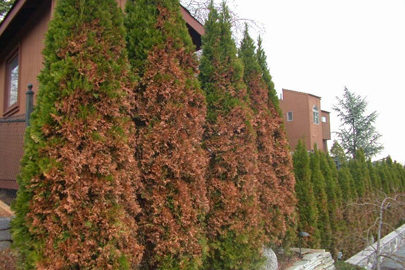How to Protect Your Plants In Winter Damage

Our landscaping expert Sue shares a few tips on you can do now to help protect your plants from winter damage.
Cold Damage
When does this happen?
This is more prevalent during fall and spring due to fluctuations in temperatures and little or no snow cover to protect and insulate plants.
What you can do…
Mulch heavily 6-8″ around the base of sensitive plants (hydrangea, crape myrtle, butterfly bush, bluebeard, roses, etc) with bark mulch or straw. Remove in spring after frost damage is over.
Sun Scald on New or Young Trees
Why does this happen?
Sun scald usually occurs on the south or southwest side on bark of young or newly planted trees. The sun heats up the bark causing cambial activity to be stimulated.As temperatures drop rapidly the tissue is killed causing a vertical wound on the tree bark.
What you can do…
Protect young trees by wrapping them with tree wrap or plastic tree guards.
Rodent Damage
When does this happen?
This damage is more prevalent during long periods of snow cover, when animals live under the snow and feed on bark and stems of trees and shrubs.
What you can do…
Protect trees your and shrubs from damage by using 1/4 ” mesh hardware cloth, plastic tree guards, or chicken wire cylinders around base.
Winter Discoloration of Evergreens
Why does this happen?
Wind and frozen ground cause winter damage and browning and drying on broadleaf evergreens and conifers.
What you can do…
Keep evergreens properly watered throughout the growing season reducing stress and winter desiccation. Use anti-desiccants like Wilt Stop in late fall to prevent winter burn. Also burlap screens can be put around base of evergreens in cold windy location.
Root Damage
What you can do…
To encourage fall root growth and reduce winter root injury, mulch new plantings in fall. We have everything you need to start mulching. If fall has been dry, water heavily before ground freezes to reduce frost penetration and heaving due to repeated freezing and thawing (moist soils hold more heat than dry soils).
